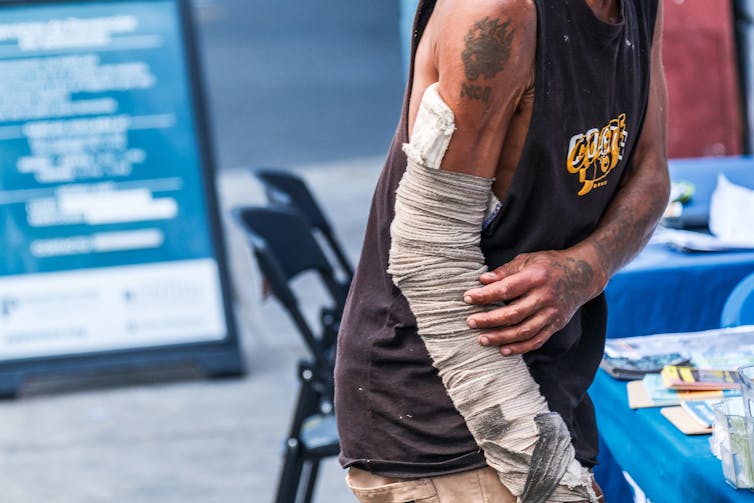
Unimaginable pain and restlessness. Vomiting so frequent and forceful that it can perforate the esophagus. Blood pressure and heart rate so high that they damage the heart. Sweating that drenches clothing and sheets. Nerve sensitivity that makes even the softest touch agonizing. A prolonged panic attack that is provoked and worsened by even mundane activities and conversations.
The withdrawal symptoms from “tranq dope” – the combination of the synthetic opioid fentanyl and the animal tranquilizer xylazine that dominates Philadelphia’s street opioids supply – tend to be far worse than those experienced by even the most severe heroin users of the past.
So it’s no surprise that people will do whatever they can to forestall them. That includes walking out of the hospital before their care is complete.
I’m an associate professor of emergency medicine who has spent a decade as an emergency physician working in Center City and South Philadelphia. I’ve spent most of that time directing projects to improve care for people who use drugs.
Beginning in 2022, our team – a group of emergency and addiction physicians – began experimenting with new approaches to treating tranq dope withdrawal.
We were able to reduce the likelihood of these patients leaving the hospital before treatment was complete by more than half – from 10% to just under 4%.
We also reduced the severity of their suffering, lowering their withdrawal scores – or how they rate their pain and other symptoms – by more than half.
Table of Contents
Traditional treatments don’t work
Before tranq dope, treating opioid withdrawal in the emergency department was relatively straightforward, with well-studied, conventional protocols.
For patients without chronic pain, health care providers started buprenorphine, known by its brand name Suboxone, when patients showed signs of withdrawal.
Buprenorphine works by partially, rather than fully, stimulating opioid receptors in the body. This subtle difference relieves symptoms of withdrawal but reduces the risk of overdose if patients continue to use other opioids. It quite literally saves lives.
Tranq dope, however, created a much larger set of challenges.
Fentanyl and other synthetic opioids are dozens to hundreds of times more powerful than heroin. Xylazine, meanwhile, adds symptoms of sedative withdrawal to the mix: restlessness, adrenaline activation and agitation.
As synthetic opioids became pervasive in Philadelphia’s drug supply over the past decade, overdose deaths in the city tripled. Those numbers are beginning to decline, for reasons that remain unclear.

Jeff Fusco/The Conversation US, CC BY-ND
Meanwhile, tranq users started to share buprenorphine horror stories. They refused the medication due to a phenomenon called “precipitated withdrawal.” Precipitated withdrawal is a condition in which taking buprenorphine paradoxically makes withdrawal symptoms worse, rather than improving them. Due to the severity of their symptoms, some patients who precipitate severely even require treatment in the intensive care unit.
Furthermore, when patients did accept buprenorphine, their withdrawal symptoms were no longer being effectively controlled, even with very high doses. We were adrift.
Patients demand discharge
When people with severe substance use disorders are hospitalized, even compassionate staff members sometimes lose patience.
Being confined to a stretcher in a loud, chaotic environment, in withdrawal, with prior traumatic health care experiences, can lead patients to act out. They might repeatedly hit call bells, use inappropriate language, make impulsive decisions or sneak drugs into the hospital.
This creates a lot of stress for nurses and staff, and distracts from the care of others.
So when patients demand to leave before treatments are complete, exhausted care teams often quickly acquiesce. Traditionally, this was termed leaving “against medical advice,” but is now called “patient-directed discharge.”
Patient-directed discharge is associated with higher rates of mortality, permanent disability and rehospitalization.
Rates of patient-directed discharge can be 10 to 50 times higher in people with an opioid use disorder compared with the general public.
A cycle of mistrust can also form, where the expectation that a patient may leave again leads to a less engaged care team, which in turn can make patients more likely to leave.
At staff meetings, some compared the challenges of caring for these individuals to those experienced in the hardest parts of the COVID-19 pandemic.
New approach needed
Many physicians have been reticent to consider other options for treating opioid withdrawal. I believe there are two key reasons for this. One is the lack of Food and Drug Administration approval for alternative treatments. The other is that federal regulations consider addiction a behavioral rather than medical condition, effectively separating most doctors from the addiction care of these individuals.
As fentanyl and xylazine became ubiquitous in Philadelphia’s street dope, local hospitals reported astronomical rates of patient-directed discharge among these patients. This was happening despite the best efforts of hospital staffs that are deeply experienced in conventional opioid withdrawal treatment.
In 2021, an editorial in the Annals of Internal Medicine journal advocated for the use of short-acting opioids for some patients’ opioid withdrawal – which is already common practice in Canada. Short-acting opioids are medications doctors traditionally use to treat acute pain.
Philadelphia hospitals started experimenting with using these previously verboten medications. That included our team at Jefferson Health.

Jeff Fusco/The Conversation US, CC BY-ND
Oxycodone, hydromorphone and ketamine
By using short-acting opioids such as oxycodone or hydromorphone, combined with a low-dose version of buprenorphine, we prevented precipitated withdrawal and treated opioid withdrawal and pain in our patients.
The low-dose bupenorphine can be increased over time to steady doses. This shows patients that the medication is safe and provides them a bridge to long-term treatment.
The short-acting opioids replace the opioids that their bodies are frantically searching for. They reduce their pain and misery, and are decreased when their symptoms are controlled.
Patients with opioid use disorder will often do whatever they can to stay out of the hospital due to fear of withdrawal. Asking how withdrawal symptoms are managed, therefore, is often their first priority when hospitalized. We see this even when they have conditions that require complicated and time-sensitive treatments.
Owing to the vast amounts of opioids many of our patients use, we also give them additional strong medications, or “adjunctive therapies,” to supplement the effects of the short-acting opioids and low-dose buprenorphine. One is ketamine, an anesthetic that affects nerve impulses and is increasingly being used to treat depression, post-traumatic stress discorder and substance use disorders.
Ketamine is also an effective pain medication that can extend the effects of opioids and reduce the number of doses needed.
We additionally add muscle relaxants – which work similarly to xylazine – along with nausea medications and IV fluids, to help give patients a chance at healing.
Side effects and future problems
In patients who received our medications, the risks of serious side effects were minimal. The few patients who suffered serious adverse effects had other acute medical problems that could have contributed to the side effects. Almost all the side effects we saw were mild and resolved on their own.
As powerful synthetic opioids and other contaminants become pervasive in more U.S. cities, more emergency departments will need to figure out how to care for patients in withdrawal so that they don’t leave treatment.
It is our hope that this work will inspire others to do a better job of providing relief to patients suffering from this complicated and severe condition.
![]()
Kory London received funding from the City of Philadelphia to support the work related to caring for individuals with substance use disorder. He is on the board of the nonprofit Council of Southeast Pennsylvania, dedicated to helping those in need of behavioral health care and support.






















